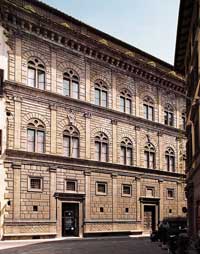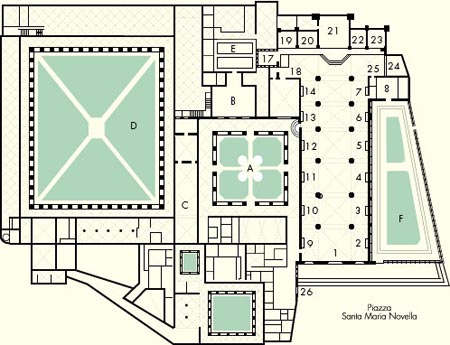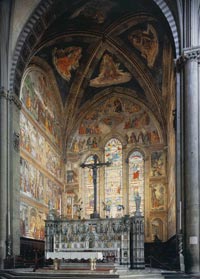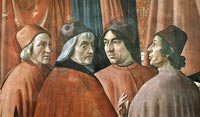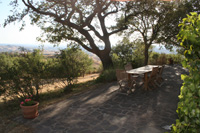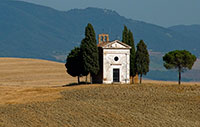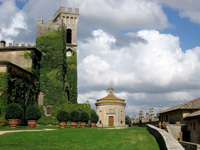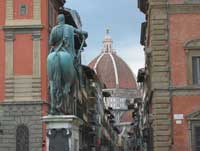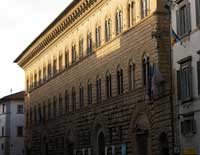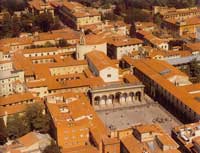Piazza Santa Maria Novella |
Walking in Tuscany | Florence | Santa Maria Novella |
| You can start this tour from Santa Maria Novella, the main railway station in Florence built in 1933/35 by Michelucci Group. Take via degli Avelli, in front of the train station and arrive in Piazza Santa Maria Novella, the church is one of the most famous and beautiful churches in Florence, rich of masterpieces. Admire the square and the façade by Leon Battista Alberti. You need the whole morning to visit the church and the Cappellone degli Spagnoli, the green cloister (Description in “Churches” section) – You can have a free tour of the church. Coming out from the church, go to the left in via delle Belle Donne there is a little square with a column: The Croce al Trebbio (1338) with the symbols of the Evangelists. |
||
Via Tornabuoni |
||
| The Via de' Tornabuoni has served as the setting for pageants and processions to the cathedral and baptistery since mediaeval times. In the 15th and 16th centuries, influential Patrician families such as the Strozzis, Tornabuonis and Vivianis built their palaces here. The Via Tornabuoni, the fashionable street of Florence, with its gay shops and Jockey Club, received its name from a family, whose history contains little remarkable, except that a lady of the house, Lucrezia Tornabuoni, noted for her literary attainments, became the wife of Piero de' Medici, and the mother of Lorenzo the Magnificent; and that Nicolò Tornabuoni, Bishop of Borgo San Sepolcoro, in 1560 introduced the use of tobacco into Tuscany, which was first known as the Erba Tornabuona.[1] Since the 18th century, these buildings have often been used as an imposing backdrop in graphical portrayals of the Via de' Tornabuoni as a place for urban promenading, whereby the visualisations by Giuseppe Zocchi, the eminent Florentine copper engraver (died in 1767) were used as templates. Emilio Burci’s view of the monumental west front of the Palazzo Strozzi towards the north points to the Palazzo Viviani and Palazzo Corsi, both bathed in sunlight, in a similarly sweeping manner. Here, the old front of the Palazzo Corsi (formerly Tornabuoni) is visible with the Cigolis Loggia, which disappeared when the road was widened in the 1860s. A purely architectural interest is hidden behind the printed elevations of individual palaces. |
||
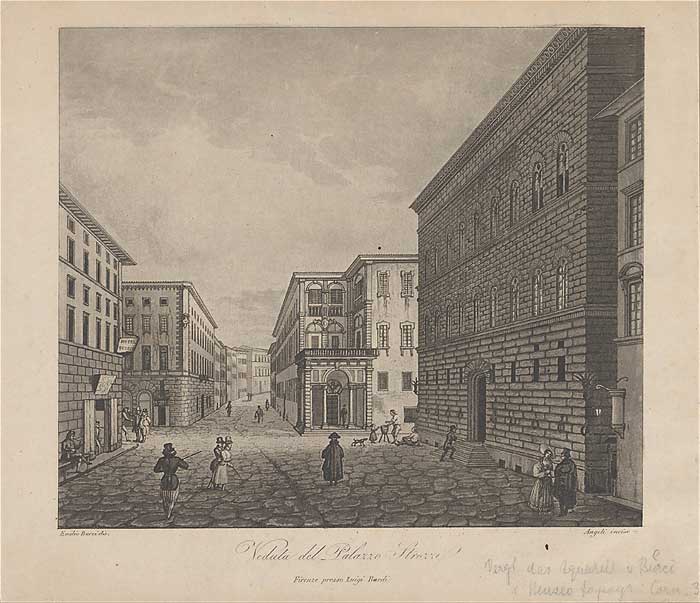 |
||
Emilio Burci, View of the Via de' Tornabuoni with the Palazzo Strozzi, circa 1840/1850, aquatint and etching, 23.3 x 27 cm
|
||
| If you go to your left, you arrive near Via Tornabuoni, if you take via Rucellai, on the right, you arrive in Piazza Rucellai, also this square was planned by Leon Battista Alberti. The important Rucellai palace was built in 1455/70. On the ground floor now there is the Museum of the History of photography Alinari Bros. The loggia dates back to 1463/66. Walk along the palace and arrive in Piazza San Pancrazio, there is one more building of Rucellai family by Alberti: the Rucellai Chapel (the entrance is in via della Spada) Inside you can visit the beautiful little temple of the Holy Sepulchre, made by Leon Battista Alberti (1467). In the ex Church of St. Pancrazio now you can visit the Museum of Marino Marini (1901/1980). Walk along these streets and arrive in Via della Scala, at nr 16 you can find the famous old Pharmacy of Santa Maria Novella. This was the ancient pharmacy of the monastery. Now walk along via della Scala and in Via Orti Oricellari (the name comes from Rucelai name), there is the palace of Venturi Ginori family. At the end of the street there is a triangular space named “Il Prato”. Here, on the right, you can see a very high old wooden door this is the “house” of the cart. The explosion of the cart is an ancient ceremony which takes part every Easter Sunday in front of the cathedral and which dates back to the first Crusade. |
|
|
|
|
||||||||||||||||||||||||||||||
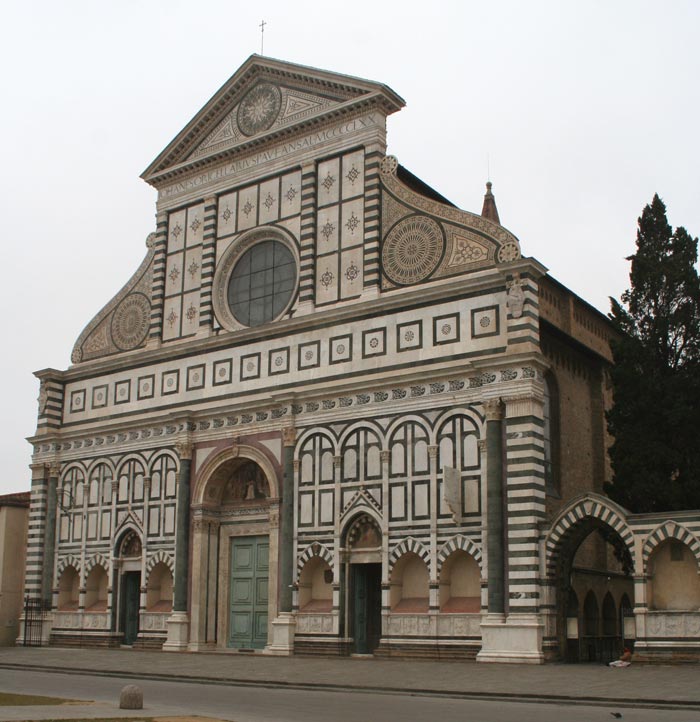 |
||||||||||||||||||||||||||||||
Florence | Santa Maria Novella |
||||||||||||||||||||||||||||||
|
||||||||||||||||||||||||||||||
[1] Walks in Florence : churches, streets and palaces, by Susan and Joanna Horner. |
||||
Art in Tuscany | Florence Piazzas | Le piazze di Firenze Art in Tuscany | Florence | Santa Maria Novella |
||||
|
This article incorporates material from the Wikipedia article Santa Maria Novella published under the GNU Free Documentation License.
|
||||
|
||||
Podere Santa Pia |
Podere Santa Pia |
Madonna di Vitaleta Chapel, San Quirico d'Orcia |
||
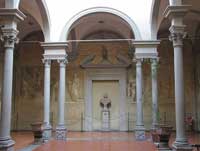 |
||||
Villa Celsa near Florence |
Piazza della Santissima Annunziata in Florence |
Choistro dello Scalzo, Florence |
||
| Chiesa di Santa Maria Novella Address | Piazza di Santa Maria Novella, 50123 Firenze (FI) Opening hours | Open weekdays 9 a.m. - 5.30 p.m. Fridays 11 a.m. - 5.30 p.m. Saturdays 9 a.m. - 5 p.m. Sundays and religious holidays 1 p.m. - 5 p.m. The museum, adjacent to the church, is managed by the city of Florence and foresees a separate admission fee. The ticket includes a visit to the Green Cloister with frescoes by Paolo Uccello with scenes from the Old Testament and, being outside, are in bad shape but can still be admired. The Chapter House, called the Cappellone degli Spagnoli or Spanish Chapel ever since it was used by the courtiers of Eleanor of Toledo, wife of Cosimo I. The chapel features frescoes by Andrea di Bonaiuto depicting Jesus Christ's passion, death and resurrection on the front wall as you enter. To the right, in the Triumph of the Doctrine, the dogs of God (a pun on the word Dominican - domini canes) are sent to round up lost sheep into the fold of the church. To the left, another fresco the Triumph of the Catholic Doctrine while the entrance wall frescoes depict stories of the life of St. Peter Martyr. The tour ends in the ancient refectory where precious liturgical objects belonging to the church's sacristy are on display as well as a few recovered synopses from Orcagna's frescoes in the Tornabuoni chapel. |
||||
| Choosing one of the Florence walking tours you'll be able to visit the world-famous museums of the Uffizi and Accademia Galleries, discovering the main historical and artistic treasures of the city. The tours focus on Florence's major sights and attractions, including the Duomo, the Ponte Vecchio and the city's famous churches and Renaissance palaces. Novelist Henry James called Florence a “rounded pearl of cities -- cheerful, compact, complete -- full of a delicious mixture of beauty and convenience.” The best way to experience the Italian city’s artistry, history and joy of life is by walking the same paths that the Medicis, Michelangelo and James once used. 1 | A Walk Around the Uffizi Gallery 2 | Quarter Duomo and Signoria Square 3 | Around Piazza della Repubblica 5 | San Niccolo Neighbourhood in Oltrarno 6 | Walking in the Bargello Neighbourhood 7 | From Fiesole to Settignano
|
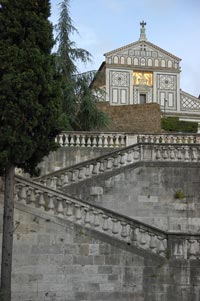 San Miniato al Monte |
|||
Palazzo Medici Riccardi, Florence |
Piazza della Santissima Annunziata in Florence |
Florence, Duomo |
||

